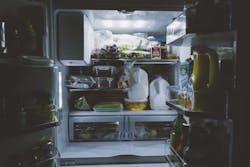Readers of LEDs Magazine will know that we regularly report on the evolving health and wellbeing benefits of modern lighting. So it is with enormous excitement that we now bring you news of a breakthrough that could potentially cure a condition afflicting as many as 80% of all adults: Refrigerator Blindness.
In the unlikely event you need reminding, perhaps because you are neither a sufferer nor a partner of a sufferer: Refrigerator Blindness, as defined by Urban Dictionary, is “loss of visual acuity in association with common foraging of the refrigerator.” In other words, you can't see the jar of mustard that's right in front of your [expletive deleted] eyes.
At long last, a remedy could be on the way — OLEDs.
Now, for our second quick review. OLEDs, or organic light-emitting diodes, are thin sheets that light up in response to electricity. Unlike LEDs, they are not single light points. Rather, their entire surface emits light. Rochester, NY's Eastman Kodak invented the devices in 1987. They have long been hailed as the future of lighting, although for a number of reasons they have so far remained more niche than mainstream.
But to their credit, makers of OLEDs continue to push on, and to imagine use cases.
One leading OLED champion, Rochester-based OLEDWorks (yes, it has a Kodak legacy), is now targeting the inside of refrigerators, where a 2-mm thin lighting panel could free up precious space occupied today by bulkier incandescent or LED fittings, and where heat emissions would be negligible.
Combine those two advantages, and you get a third one: You could place several OLEDs throughout the refrigerator walls, top, bottom, and center. No longer would the lasagna tray cast a long shadow over the vegetables below. With apologies to KT Tunstall, countless sufferers could be singing "Suddenly I See."
“Integration on interior side walls or underneath shelving allows for the incorporation of more light in locations closer to the contents without sacrificing storage volume, and low heat output means that OLEDs placed directly above food items won’t sacrifice food freshness,” wrote OLEDWorks director of OLED user experience Kathleen Vaeth on the company's blog.
Vaeth pointed out that other OLED attributes would also apply, such as certain color rendering properties of OLEDs. (Food for thought from those of us at LEDs: Your carrot versus parsnip optical deficiencies could become history.)
OLEDWorks did not reveal any partnerships or commitments from refrigerator makers. So the company appears to be more in the conceptual stage, as it eyes new markets.
“The refrigerator was chosen as an ideal candidate for OLED integration because a key attribute that consumers consider when purchasing a refrigerator is the available volume inside the unit,” Vaeth said.
It is reminiscent of a market vision from last summer, when Vaeth and OLEDWorks talked up the benefits of outfitting recreational vehicles with OLEDs.
It's all part of OLEDs' long, slow emergence in general lighting as developers lower prices and improve efficiencies.
OLEDs are also finding specialty, niche, and architectural design uses. OLEDWorks will be supplying tail lights to Audi, for example.
OLEDWorks and other OLED backers continue striving to bring bigger OLED meals to the broader lighting table.
MARK HALPER is a contributing editor for LEDs Magazine, and an energy, technology, and business journalist ([email protected]m).
For up-to-the-minute LED and SSL updates, why not follow us on Twitter? You’ll find curated content and commentary, as well as information on industry events, webcasts, and surveys on our LinkedIn Company Page and our Facebook page.

Mark Halper | Contributing Editor, LEDs Magazine, and Business/Energy/Technology Journalist
Mark Halper is a freelance business, technology, and science journalist who covers everything from media moguls to subatomic particles. Halper has written from locations around the world for TIME Magazine, Fortune, Forbes, the New York Times, the Financial Times, the Guardian, CBS, Wired, and many others. A US citizen living in Britain, he cut his journalism teeth cutting and pasting copy for an English-language daily newspaper in Mexico City. Halper has a BA in history from Cornell University.





